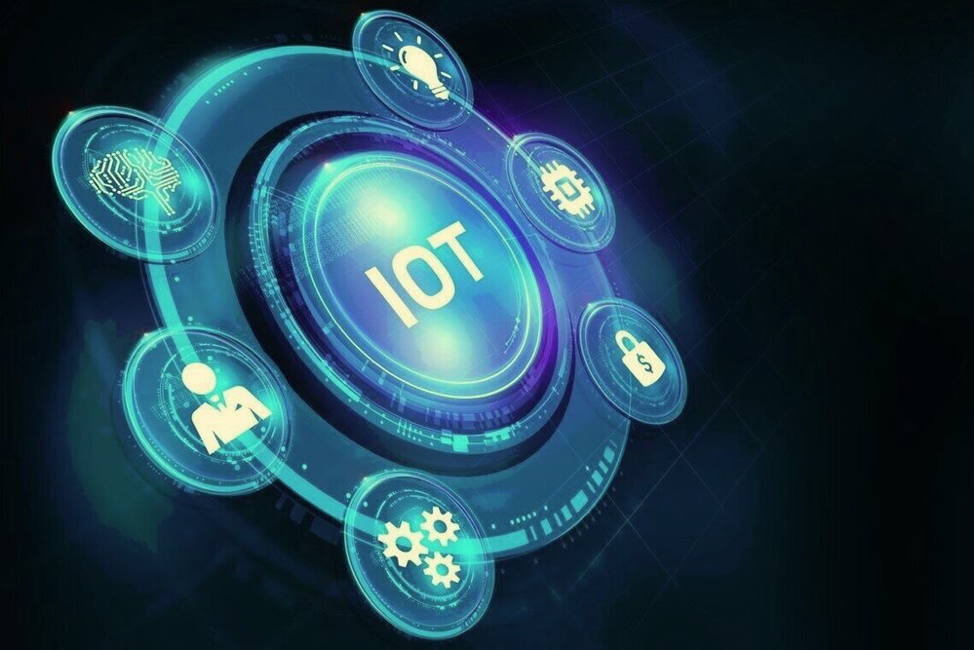Editor’s Note: The DBizInstitute is excited to share this article, written by Dr. Setrag Khoshafian, with our community and in advance of his new book release. Keep an eye on our website as we share additional articles in the coming months written by Setrag, as well as a pending Meet the Author webcast to discuss his new book ‘How to Alleviate Digital Transformation Debt’ expected to air Fall 2021. This article was originally published on CognitiveWorld.com on December 14, 2020.
This article is the eighth installment in a ten-part series on Digital Transformation Debt, post-Covid-19. Part 1 focused on Culture, while Part 2 delved deeper into Operational Excellence and inter-enterprise Value Streams As A Service (VSaaS). Part 3 explained the spectrum of Automation and the shifts post-Covid-19, and Part 4 demonstrated how a new harvest of Low Code/No Code platforms is empowering Citizen Developers. Part 5 highlighted the emerging trend of tools and best practices for Citizen Data Scientist. Part 6 focused on pragmatic innovation – primarily through the increasingly popular Design Thinking Methodology leveraging digital technologies for innovation, and Part 7 focused on the Customer Experience Optimization.
Covid-19 is causing rapid acceleration of Digital Transformation (DX) initiatives
According to the Covid-19 digital engagement report from Twilio: “Decade-long digital transformation roadmaps of nearly every company got compressed into days and weeks in order to curb the spread of the Coronavirus. Businesses in every industry had to figure out how to reach their customers – whether those customers are shoppers, patients, students, businesses or even, employees – essentially overnight.”
This reiterates the importance of Digital Transformation Debt.
IoT for a connected world is essential for Digital Transformation.
One forecast predicts 75 billion devices by 2025.
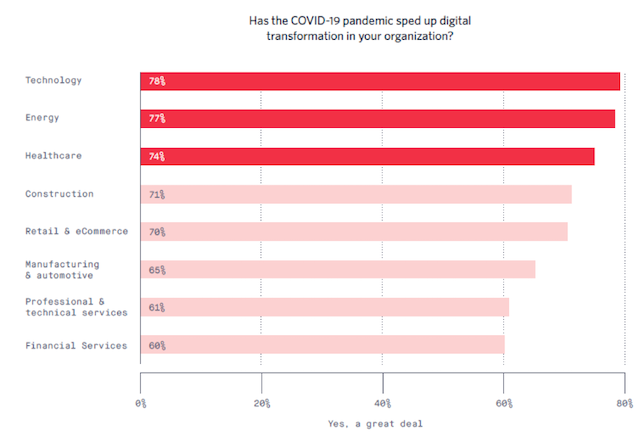
Part 8 of the ten-part series on Digital Transformation Debt expands upon the emergence of the Connected World – through Internet of Things (IoT). Though a bit slow in comprehensive market penetration, both Consumer Internet of Things as well as Industrial Internet of Things (IIoT) are starting to transform homes, businesses, and governments as well as heavy industries such as discrete and process Manufacturing. This transformation is accelerating in the Covid-19 era. IoT has many applications for the Covid-19 challenges emanating from the disruptions in Supply Chain, Manufacturing, Public Sector services, and, most importantly, Healthcare. IoT connected devices are exploding. The road to IoT success though, runs through Digital Process Automation – which we have now identified as Intelligent Process Automation of Things – connecting the consumer’s world through end-to-end value streams orchestrating people, things, enterprise applications, and business partners.
Intelligent Process Automation of Things (IPAoT)
Many components and technologies are used to support IoT/IIoT use cases end-to-end: from the Edges to the Enterprise – involving People, Processes, Analytics (from Thing Data) and of course Connected Devices. Many components and technologies are used to support IoT/IIoT use cases end-to-end: from the Edges to the Enterprise – involving People, Processes, Analytics (from Thing Data) and of course Connected Devices. There are also IoT reference models that pertain to IoT consortia and/or standardization bodies. My favorite is the IoT World Forum’s Reference Model. This seven-level architecture reference model puts collaboration and Business Processes at the top of the multi-level architecture for IoT.
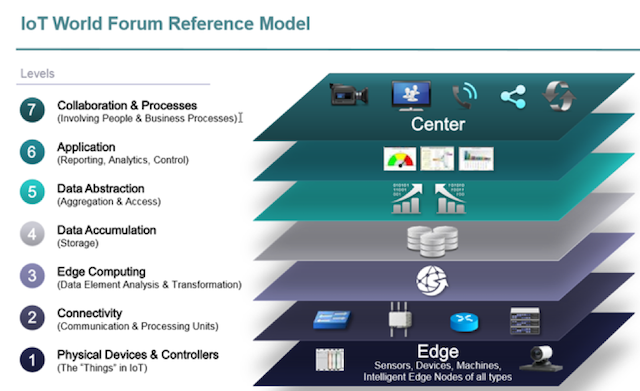
Intelligence of Things: Insight to Action
IoT is generating enormous amounts of data. We are inundated with information from connected devices – both in consumer and industrial contexts – and it does not appear to be letting up any time soon. Connected devices are becoming increasingly significant sources of information: Big Data will is becoming “Thing Data.” Over time, the Thing data will be stored, analyzed, and mined for models that reflect insights – that can then be acted upon, such as analytics model that can predict a device will fail before it happens.
The following illustrates the continuous improvement loop from Insight to Action. At the bottom, you have the raw data emanating from connected IoT/IIoT devices. The raw data could also include customer transaction data, trading partner data, and even Blockchain transactions.
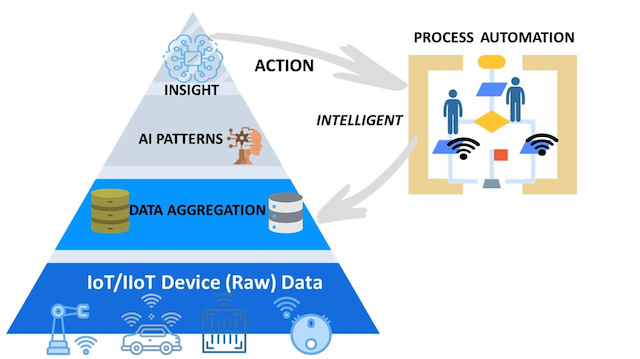
With Intelligent Process Automation of Things (IPAoT), connected devices (IoT), people, enterprise applications (ERPs), and trading partners can collaborate and achieve objectives end-to-end. Equally important is the Intelligence that drives the processes in each step and each state towards the objective. The AI patterns discovered from the Thing Data is operationalized and acted upon in the context of automated processes. So, AI is leveraged for optimizing the operation of the devices real-time, assisting people intelligently, automating the work whenever it makes sense.
Edge Computing
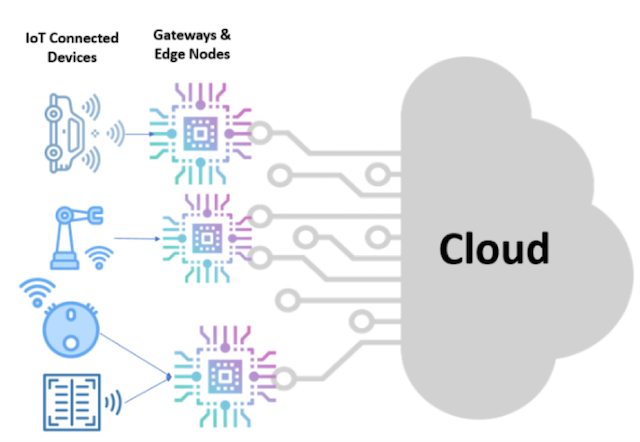
IoT connected devices are at the edges – lowest level – of the Enterprise-In-Motion ecosystem. The Internet of Things (IoT) and the Industrial Internet of Things (IIoT) are significant contributors to Digital Transformation.
When it comes to autonomic IoT, the emerging connected devices trend is Edge Computing. Increasingly business logic and AI models are executing at the IoT edges. There are many advantages to executing AI models at the edge. In many applications, instantaneous decisions need to be made dealing with, for instance, hazardous material, or dangerous levels of pollution, or even emergency dispatching. The delays of roundtripping from a Cloud-based data center for AI model execution could be prohibitive.
In some cases, Internet connectivity might have unacceptable latencies or even be off-line. The actuators and sensors of connected devices often leverage gateways to connect to the Cloud. The connected devices and the gateways are becoming increasingly powerful in storage, computation, and networking optimizations. Pushing computations and Intelligence to the edges reduces the latency of executions.
The Industrial Internet Consortium defines it as follows: “Edge computing is a decentralized computing infrastructure in which computing resources and application services can be distributed along the communication path from the data source to the cloud.” Edge computing allows devices take immediate action. In other words, edge computing is faster and more optimized.
Digital Prescriptive Maintenance: The Killer IoT Application
Digital Prescriptive Maintenance leverages IPAoT and takes it beyond predictive analytics and prescribes exactly what needs to be done, by whom and when – leveraging end-to-end digitized value streams or processes. IPAoT determines the remaining useful life of a device and takes pro-active predictive action before it breaks. That is why we called it digital prescriptive maintenance: it implies the Digitization and Automation of the prescribed tasks to resolve the maintenance case. Here is an example of end-to-end prescriptive analytics: from detection to the creation of the case, to triaging, to field service dispatching, to supplier provisioning, to warranty.

IoT and Covid-19
The Covid-19 pandemic exposed the vulnerability of both the private and public sectors in managing assets. There are still products – such as hand sanitizers of Webcams – that are either difficult to find or expensive. With IoT, the assets could be the manufactured goods, or the assets can be the connected devices themselves. They could be simple devices with low energy and communication bandwidth capabilities that need a more sophisticated gateway to connect to the Cloud. In the Industrial Internet context, powerful connected devices have onboard computing capabilities that allow them to process data at the edges and connect to the Cloud through WiFi or 5G connections. Alternatively, RFID could be attached and embedded in the packaging of the goods for manufactured goods – for instance, in transportation with containers.
Telehealth and Covid-19: There was a recent spike in Telehealth due to Covid-19. What is telehealth in the Covid-19 era? IoT – with connected medical devices – plays a significant role: “The Internet of Things (IoT) has extended traditional videoconference visits to enable practitioners to remotely monitor patients’ blood pressure, oxygenation levels, pulse and other key metrics.” More importantly, it is not just about sensing. Telehealth needs digitized and automated processes. As indicated by one of the experts Dr. Peter Fleischut, “It’s about people, process and technology… It’s probably 80% people, 15% process and 5% technology.”
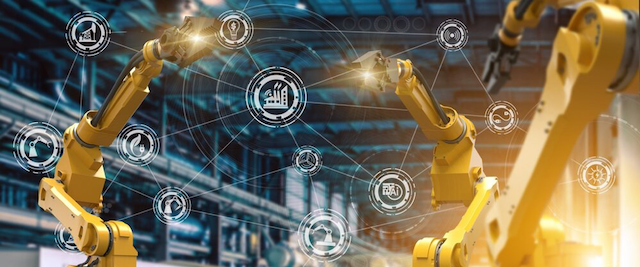
Industry 4.0: even before the pandemic, manufacturers were introducing Automation and sophisticated robotics, and edge computing in all phases of the supply chain. With Covid-19, Robotics and Automation are becoming critical in Industry 4.0. The manufacturing industry – especially automotive original equipment manufacturers (OEMs) – were in a significant digital transition, and Covid-19 accelerated and increased the transformation. Service levels of assets – often parts in supply chain applications – could be critical. Automation is also increasingly deployed at the edges – which alleviates or reduces the need for human interventions or contact.
The opportunities for addressing Covid-19 challenges pertain to tracking people’s movements, provisioning, and delivery of supplies:
- Tracking of People under Quarantine: Many countries are leveraging IoT technologies to track people. For example, South Korea’s Ministry of Interior and Safety has developed an app that uses GPS to track those ordered to quarantine.
- Supply Chain Tracking and Optimizations: IoT tracking is becoming increasingly important in the end-to-end supply chains, primarily due to the pandemic disruptions. End-to-end asset visibility is becoming a requirement for manufacturers—optimization of the service level agreements for end-to-end delivery of the connected assets.
- IoT Intelligence at the Edges: Covid-19 responses need to be real-time and intelligent. In many applications, the delays of roundtripping from a Cloud-based data center for AI model execution could be prohibitive. Increasingly business logic and AI models are executing at the IoT edges. There are many advantages to executing AI models at the edge.
Let us look at a couple of Healthcare service Internet of Medical Things (IoMT) examples for Covid-19.
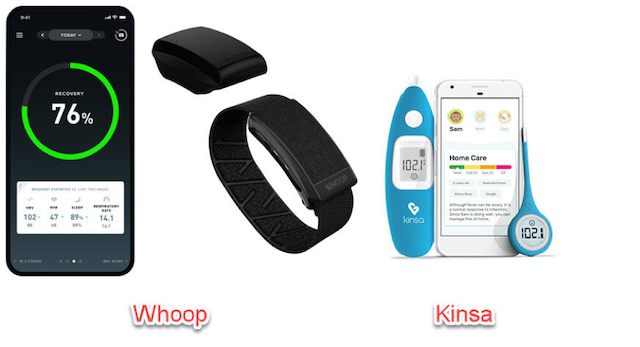
- Kinsa: Fever is considered one of the leading indicators of Covid-19 infection. Kinsa has millions of connected thermometer consumers and is collaborating with local governments and health authorities – as temperature screening remains critical for avoiding the spread of Covid-19. The temperature data of the connected thermometer is aggregated anonymously and displayed per county.
- Whoop is a fitness tracker with a band and mobile app monitoring measures such as heart rate variability, resting heart rate, and sleep. Whoop responded to the Covid-19 pandemic by updating their mobile app to monitor and interpret respiratory rates. Covid-19 attacks the lungs. Therefore, monitoring respiration is critical to managing Covid-19. Monitoring respiration “helps determine how much change you need to confidently conclude that a change is meaningful and not random variation. Median respiratory rate has a remarkably high signal to noise ratio, making it very easy to interpret and trust.”
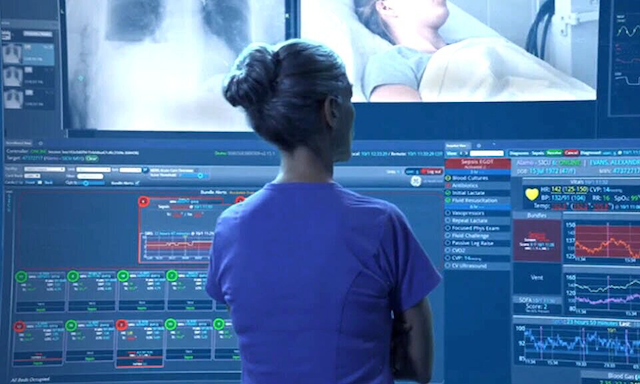
- GE Healthcare’s Mural Virtual Care Solution, which aggregates data and monitoring from several systems “into a single pane of glass providing hospitals the ability to extend clinical capabilities and resources by giving visibility to at-risk and ventilated patients while minimizing exposure to staff.” This allows virtual monitoring through “near real-time data from ventilators, patient monitoring systems, electronic medical records, labs, and other systems.” The solution “allows one clinician to monitor several patients at once, supplementing existing monitoring devices in patients’ rooms.”
Recommendations
The post-Covid-19 era is a connected world! All industries are accelerating their Digital Transformation initiatives and IoT is a critical technology for DX. Here are our recommendations for alleviating IoT Digital Transformation Debt:
- IoT Platforms and Interoperability: IoT is complicated. There are more than 600 IoT platforms for a plethora of IoT capabilities. Khosh Consulting can help you select the platforms and solutions that are best fit for your needs.
- IoT No Code Development: The emergence ofLow Code/No Code Citizen Developers for IoT will become critical. Khosh Consulting provides best practices for IoT No Code Development – identifying the right tool for your needs.
- IPAoT: Any IoT strategy needs to include an end-to-end business process orchestration strategy. Khosh Consulting innovated IPAoT and has decades of experience for your IoT-centric Business Process Management and Automation needs: the road to IoT success runs through intelligent BPM!
But perhaps most importantly, the focus of IoT initiatives should be on concrete ROI – all specialties of Khosh Consulting:
- Subject Monitoring and Responding: Monitoring to optimize insurance of Smart Homes, wellness tracking, health monitoring, Smart City transportation, connected car applications in numerous Car-to-X (Car, Infrastructure, OEM) – to name a few.
- Asset Monitoring and Responding: There are compelling ROI’s while monitoring the status or condition of the connected assets which can allow you to then take action – through IPAoT.
- Data Monetization: There are ROI opportunities through data monetization. Many Insurance companies – especially in automotive – leverage data to adjust Insurance costs depending on how you drive, drive, drive, etc.
- Predictive Maintenance: This is the killer application for IoT. With AI analytics, it is possible to determine a device’s remaining useful life and take pro-active predictive action before it breaks.
This is a ten-part article series centered around Digital Transformation Debts in the wake of the Covid-19 pandemic. Be sure to check out all ten articles!
